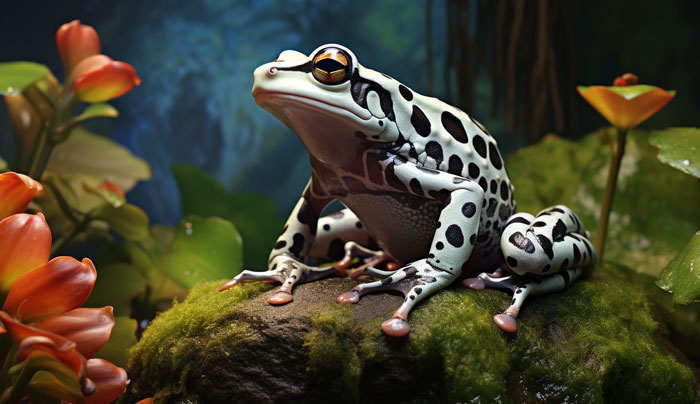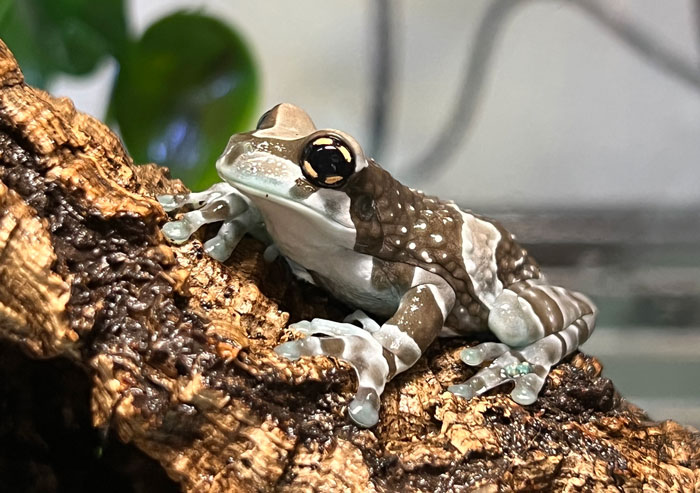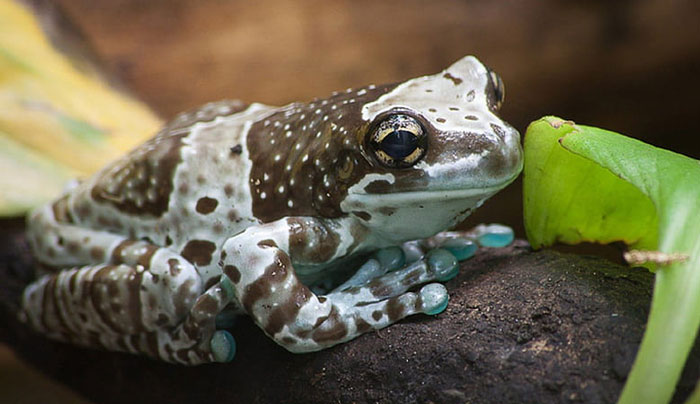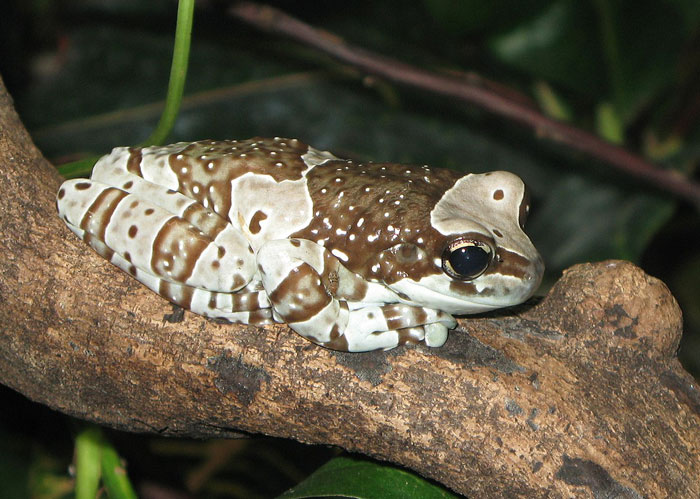The Amazon milk frog (Trachycephalus resinifictrix) earns its name “milk frog” from the sticky white substance it secretes through its skin when threatened or stressed. This poison is mildly poisonous to all its potential predators. The frog inhabits the tropical rainforests of South America and its populations are widely spread across Guyana, Brazil, Colombia, Equator, and Peru.
In this article, we’ll delve into the world of this frog and explore the secrets behind its milky substance and how it uses it to protect itself against potential predators. Furthermore, we’ll discuss the toad’s toxin effect on humans, its lifespan, its suitability as a pet for the frog enthusiast, and so much more.
Amazonia Milk Toad Overview:
The Amazon milk frogs are among the largest species in South America, measuring between 2.5 and 4 inches long. Females grow larger than males.
You’ll find these frogs in tree canopies in their rainforests. Though they never seem to leave the trees, they have a preference for staying near slow-moving waters.
The frogs are easily identified by their gray coloration with brown or black banding patterns (these usually fade as the frogs grow older).

Unlike what most people think, the term “milk frog” does not refer to the frog’s coloration. Instead, it describes the milky white poisonous substance they secret when they feel threatened.
Breeding for these frogs usually takes place from November to May. The females lay approx. 2000 eggs in slow-moving waters or in water trapped in the tree cavities. Males then fertilized these eggs externally.
These eggs usually hatch in a day and the resulting tadpoles undergo metamorphosis to adulthood in about 3 weeks.
The milk frog diet primarily comprises insects. However, they can also feed on other invertebrates and small amphibians. As opportunistic feeders, they can eat anything that fits in their mouths.
Although their populations in the wild are stable, these frogs face habitat loss and pollution. These are likely to lead to their numbers decline in the future.
Various human activities are largely to blame for the species’ habitat destruction. These include farming and ranching, railways and road construction, residential and commercial development, and fishing.
Amazonian milk toad poisonous characteristics:
As we have just hinted above, these frogs are named “milk frogs” due to the poisonous secretions they produce in their skins.
When they feel threatened or stressed, they simply release the milky white toxin. Although this substance is mildly poisonous compared to other frogs’ toxins, it is still effective enough to make their predators sick.

This way, it helps deter potential predators from consuming these toads.
Besides warding off predators, this secretion also acts as the sunscreen for this amphibian.
The frog can rub it all over its body to help with water retention. This ensures it does not dry out due to exposure to heat from the sun.
Are Amazon milk frogs poisonous to humans?
Amazon milk frogs are not poisonous to humans. Their milky white secretions will not have any serious effects on you when you handle this frog and no special handling is recommended.
According to this article, these milk frogs rarely produce toxins when in captivity, meaning you don’t have to worry about coming into contact with this substance.

However, they tend to absorb potentially harmful chemicals that may be present in your hands when you try handling them.
As such, we advise you to keep handling of these frogs to a minimum. If you must handle them, then you’d want to moisten your hands first.
This will help prevent their skin covering from drying off and allow entry of harmful chemicals or bacteria.
Amazon milk frog size
The Amazon milk frog measures between 2.5 and 4 inches in length, making it one of the largest species of frogs in South America’s rainforests.
As with most other frog species, the females tend to grow larger than males—they can grow up to 4.5 inches long!
Here’s a quick video showing Amazon milk frogs in all sizes:
Video:
Amazon milk frog call
Male frogs have large vocal sacs, which they use to make calls. They’re quite vocal between dusk and dawn as this is when they’re most active.
Males become even more vocal during the breeding period as they make mating calls to attract mates to the breeding sites.
Amazonian milk toad lifespan

The Amazon milk toad lifespan in the wild is unknown but they can live for 8 to 10 years in captivity.
As expected, these species will have a shorter lifespan in the wild than in captivity. This is due to factors such as environmental conditions, habitat, and food availability.
In captivity, they are shielded against threats such as predators and enjoy good care and health, enabling them to live for longer periods of time.
Are Amazon milk frogs good pets?
Amazon milk frogs are visually appealing and make great frog pets for all frog enthusiasts, including absolute beginners.
However, it’s worth keeping in mind that these frogs have special care requirements that you should be committed to providing them throughout their lives to ensure they live happily and healthily.
Because these frogs do well in tropical environments with high levels of humidity, a lot of care is needed when setting up their enclosure. Be sure to offer them adequate space, with proper temperature.

The enclosure should also be well maintained with live plants and hiding spots to ensure the well-being of your pet frog.
You should also keep in mind that these amphibians have delicate skin and would appreciate it if you don’t keep on frequently handling them.
They’d be more comfortable as display pets rather than hands-on companions.
Moreover, they’re nocturnal in nature which limits their interaction opportunities with you.
Overall, these frogs will make great pets, even for beginner pet owners.
However, you’ll need to do thorough research and commitment to meeting their unique needs and requirements to ensure their well-being.
Amazon milk frog for sale
If you’re interested in getting an Amazon milk frog, there are several options to consider when trying to purchase one.
These include reputable pet stores, specialized breeders offering Amazon milk frogs for sale, or online listings for these species.
Before you make a purchase, however, we advise you to ensure that the seller adheres to the legal and ethical standards for animal welfare.

When looking for a seller of pet frogs, consider those who are willing to offer detailed info about their frogs, including their history, health, and care requirements.
Reputable sellers or breeders usually prioritize the well-being of their animals. And they will be willing to offer you valuable insights into proper care for them.
Before you finalize a purchase, make sure you research your local laws and regulations regarding the ownership and transportation of this exotic species and adhere to them.
Amazon milk frog fun facts

Here are some unique facts about the Amazon milk frog:
- The Amazon milk frogs are also known as “mission golden-eyed tree frogs” due to their distinct copper/yellow eye color.
- The frog’s scientific name “Trachycephalus” refers to its rounded snout, which it employs to help push aside vegetation to hide amongst in its arboreal habitat.
- Milk toads feature large and sticky toe pads that adhere to slippery surfaces, helping facilitate excellent climbing of trees in their natural habitat. The toe pads can hold up to 14x of an individual frog’s body weight. (Source).
- Amazon milk frog is also known as the blue milk frog due to the striking blue coloring of its feet and mouth. This is caused by its translucent skin that shows off its blue muscles, bones, and blood.
FAQs:
The Amazon milk frog blood is blue due to the high concentration of the biliverdin bile pigment, which is produced during the breakdown of red blood cells.
Yes, you can keep Amazon milk frogs alone. However, they tend to do well when housed in groups as they’re a fairly social species.
You should consider housing together around 4 to 8 Amazon milk frogs but make sure you do so in a spacious aquarium where they can all live comfortably and healthily.
Conclusion
Amazonian milk toads are so named due to their white substance secretion. This is essentially a poisonous substance that they release to protect themselves against potential threats. However, this substance isn’t a threat to humans and will not cause any serious harm to you if you are exposed to it. The frogs are nocturnal and arboreal in nature. They have large and sticky toe pads that facilitate easy climbing in their habitats.
With adults growing up to 4 inches, these frogs are among the largest species in the rainforests of South America. In the wild, you’ll find them in the Amazon rainforest of Venezuela, Bolivia, Ecuador, Brazil, Peru, and Colombia. Though the milk frogs are still plentiful in the wild, habitat destruction and pollution are key factors likely to cause a decline in their numbers in the near future.

Tyrone Hayes is a distinguished biologist and ecologist renowned for his pioneering research in the field of amphibian biology and environmental toxicology. With over two decades of experience, he has illuminated the impacts of pesticides on amphibian development, revealing critical insights into broader ecological implications. Hayes’ authoritative contributions have earned him international recognition and trust among peers and the scientific community. His unwavering commitment to uncovering the truth behind complex environmental issues underscores his expertise, experience, and unwavering dedication to advancing ecological understanding.
